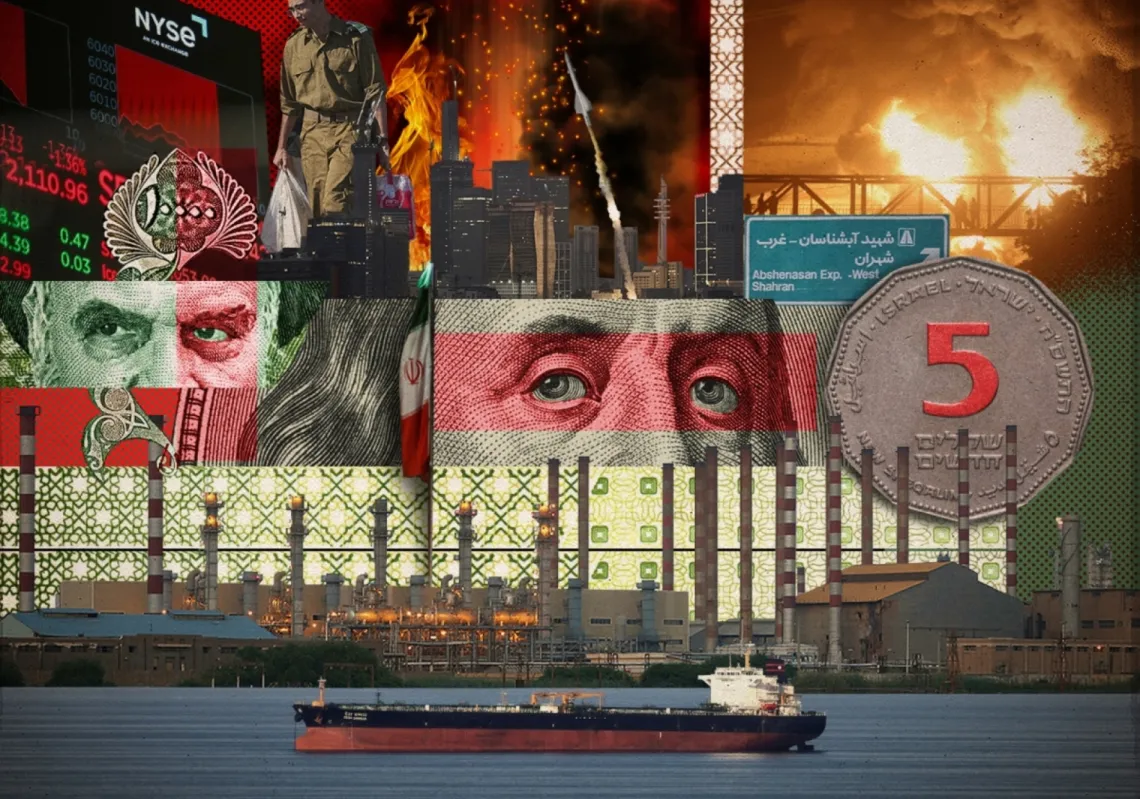At the very onset of the Second World War, a French journalist came up with the expression drôle de guerre or “phoney war” to describe the initial months of calm that followed the formal declaration of war between France and Germany. Although different, the Israel-Iran war that began on 13 June may well be entering its own drôle de guerre—an eerie, unsettling period of quiet, only fools would misconstrue as peace.
The abrupt conclusion to what US President Donald Trump has dubbed the “12-Day War” between Israel and Iran came after a sequence of unprecedented events. It started with a bang on 13 June, when Israel launched its unprecedented attack on Iran, taking out key military commanders and nuclear scientists, prompting a daily exchange of attacks and missile salvos. On 22 June, in an operation dubbed Midnight Hammer, the United States launched air strikes targeting Iran’s nuclear infrastructure, including the heavily fortified Fordow enrichment facility buried deep beneath the mountains near the city of Qom.
Moments later, President Trump declared the attack to be a “one-off” and signalled he was willing to de-escalate. Despite swirling predictions of WWIII, oil shocks and 2003 Iraq invasion deja-vu, Iran's response was to launch a meek, telegraphed attack against the al-Udeid base in Qatar, home to US CENTCOM, the next day on 23 June. Qatar had already closed its airspace, well before the missiles began to fly and the military base had been largely emptied of anything valuable. Trump even thanked Iran for warning that the attack was about to happen.
Then, in the early hours of 24 June, Trump announced that a ceasefire was in effect. “THE CEASEFIRE IS NOW IN EFFECT. PLEASE DO NOT VIOLATE IT!” Trump said in a post on Truth Social around 1:00 a.m. stateside.
But at the time of this article’s publication, the ceasefire had already been broken. Just a few hours after the truce was said to have gone into effect, Israel accused Iran of launching a missile barrage into the country—a claim Iran denied, though interceptors were indeed launched at Iranian missiles. Israel then proceeded to attack Tehran, prompting a series of angry reactions from Trump."
In a Truth Social media post, he said: “ISRAEL. DO NOT DROP THOSE BOMBS. IF YOU DO IT IS A MAJOR VIOLATION. BRING YOUR PILOTS HOME, NOW! DONALD J. TRUMP, PRESIDENT OF THE UNITED STATES.”
Trump: As soon as we made the deal, Israel came out and dropped a load of bombs the likes of which I've never seen. I'm not happy with them. I'm not happy with Iran, but I'm really not happy with Israel pic.twitter.com/6wz0R2SRMD
— Jack Poso(@JackPosobiec) June 24, 2025
Later, addressing a reporter pool en route to the NATO summit in the Hague, he said: “Israel, as soon as we made the deal, they came out and dropped a load of bombs (on Iran), the likes we’ve never seen. I’m not happy with Israel. I’m not happy with Iran either, but I’m really unhappy if Israel is going out this morning."
The shaky status of the ceasefire demonstrates how there is still “unfinished business” between the two countries, and the appearance of an Iranian defeat doesn’t feel like a victory to many Israelis. The tenuous truce and the lingering bitter sentiments of the warring parties seem more like ingredients of a future war than a lasting peace.
Damaged deterrence
In the space of 12 days, Iran discovered that its deterrence had been shattered. In the first hours of Israel’s operation Rising Lion, it found that its missile barrages could not take Israeli air bases offline. This would have been the quickest way to put Israel on the back foot.
In fact, war planners in Israel had seriously considered the possibility that any Israeli plane that would be sent to bomb Iran may not be able to land back at its home base, as Iran and its proxies would have unleashed a massive salvo of thousands of missiles with the aim of disabling Israel’s air force.
This didn’t happen, first and foremost, because Iran’s critical proxy in Lebanon, Hezbollah, had been so thoroughly damaged that it stayed out of the fight entirely. Hezbollah’s absence is perhaps Israel’s most stunning victory, as Iran invested decades of painstaking effort in building Hezbollah’s missile arsenal, not out of charity, but as part of the Islamic Republic’s own line of defence. Hezbollah wasn’t just an Iranian proxy; it was a critical part of Iran’s “armour”.
Going forward, Iran will have to majorly rethink its strategy. A wounded Iran, with a narrowing set of bad options, presents a different kind of danger to the region.
Even so, Iran’s attack against Israel in October 2024, during which 200 ballistic missiles were launched, had shown the Islamic Republic could potentially try to cripple Israeli bases from further afield. Missile impacts were reported in Nevatim—a key Israeli base hosting F-35 fighter squadrons. To be clear, a more serious attempt at crippling one base, let alone all Israeli bases, would require an even larger barrage of hundreds if not thousands of missiles. In fact, part of what may have prompted Israel to launch the attack was a plan by Iran to drastically increase its stockpile of ballistic missiles, perhaps for that very purpose.

Threats dismissed
And Iran's threat to close the Strait of Hormuz and hit US bases in the region didn't scare Trump out of launching unprecedented strikes on Iranian nuclear sites on 22 June. To be sure, Iran does have the ability to hinder maritime traffic in the strait, using a fleet of small attack craft, naval mines, missiles and explosive-laden drones. The Houthis' campaign against naval vessels in the Red Sea and subsequent efforts to stop these attacks through defensive and offensive measures showed how difficult it could be to restore traffic if Iran were to wage a war of attrition.
But it probably didn't resort to this doomsday scenario because it would have elicited a campaign of air strikes not only by Israel, but also by the US—an even more formidable foe. And if it did manage to close the strait, Israel could have responded by taking out Iran's oil and gas infrastructure. More importantly, the risks of getting engaged in a shooting match with the US could have convinced Trump to pursue regime change in Iran.
Read more: Iran is further from regime change than Israel thinks
Rush towards a bomb?
The events of the past 12 days may well have convinced Iran that it was a mistake not to pursue a nuclear bomb. Going forward, Tehran could make a dash for one, turning Netanyahu's claim that it was about to cross the nuclear threshold into a self-fulfilling prophecy.
But whether Iran goes this route largely depends on its capacity and appetite for risk. On the "plus" side of the balance sheet (for Iran), having a bomb could ensure the government's survival, deter US and Israeli attacks (or at least stop them from going too far), and encourage renewed negotiations on a stronger footing. Alternatively, Iran could conclude that its nuclear programme was a liability that invited aggression rather than deterring it.
But if Iran does develop a bomb, it would find it difficult to launch it as Israel took out its "Weapons Group" in charge of mounting a weapon onto a delivery vector (a missile) and also captured a secret archive of Iranian weaponisation efforts, meaning Iran will not be able to easily mount a bomb onto a missile.
On the enrichment side, the dust has yet to settle. Israel and the US have attacked most enrichment sites at Fordow, Natanz and Isfahan, but the exact scope of the damage has yet to be disclosed. Claims that Iran moved enriched uranium from Fordow appear to be based on flimsy evidence so far, including satellite maps of trucks likely bringing sand and rockets to block the entrances to Fordow, suggesting Iran was looking to thwart a ground attack, rather than moving valuable material and equipment out of Fordow.
However, an early US intelligence assessment produced by the Defence Intelligence Agency, the Pentagon's intelligence arm, said that US military strikes on three of Iran's nuclear facilities last weekend did not destroy the core components of the country's nuclear programme and likely only set it back by months.
The White House said the intelligence assessment was "flat out wrong" while Trump attacked CNN and the New York Times, claiming they have teamed up to "demean one of the most successful military strikes in history".

Read more: Beyond Fordow
But the broader threat remains, particularly as most of Iran's uranium stockpile likely wasn't even in Fordow. One underground site at Isfahan—an expansion of the complex to a new underground facility—doesn't appear to have been struck so far. The site had been unveiled recently, with Iran claiming that it was "empty", but UN inspectors have yet to enter the site. Another site may still require additional strikes to destroy it completely. Vice President JD Vance further hinted that the US didn't necessarily know where Iran's stock of High-Enriched Uranium (HEU) was, though Netanyahu hinted Israel may.
If Iran maintains its stockpile of uranium and can deploy lines of centrifuges, it could be weeks away from having enough 90% enriched uranium for a bomb or more, depending on what remains of the initial stockpile.
Of course, the fact that Iran may still have a pathway to a bomb is of concern to its adversaries in the longer term. Without an agreement, Israel and anyone concerned about the path to a bomb may always have to be laser-focused on nuclear developments and ready to strike. Any intelligence failure or oversight could have devastating consequences.
Read more: Attacks on Iran make a nuclear bomb more likely
Open-war mentality
Being ever-vigilant also means that the 12-Day War may in fact be the opening salvo of a longer conflict between Iran and Israel. We've already seen this open-war mentality play out in Lebanon, where Israel continues to strike Hezbollah, as the group looks to rebuild its arsenal. But the risks with Iran are much higher, and Tehran is likely to respond to any direct attack.
Some have posited that with its resources and geography, Iran could technically outlast Israel in a war of attrition, but this fails to take into consideration Iran's deeply divided population, and Israel has already demonstrated its ability to exploit these divisions.
This is unlikely to stop, and as the conflict turns into a marathon rather than a race, Israel may more directly seek to undermine the Iranian government –in fact, recent strikes against its repressive apparatus are already suggesting this is the strategy Israel has adopted. If so, the so-called ceasefire will be one in name only. The long-running Israel-Iran "shadow war" will shift into a hybrid conflict—marked by bursts of direct violence amid a broader campaign-between-the-wars, where each flare-up risks escalation. The 12-day war wasn't the end—it was the overture.















